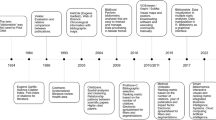Abstract
The application of online analytical processing (OLAP) technology to bibliographic databases is addressed. We show that OLAP tools can be used by librarians for periodic and ad hoc reporting, quality assurance, and data integrity checking, as well as by research policy makers for monitoring the development of science and evaluating or comparing disciplines, fields or research groups. It is argued that traditional relational database management systems, used mainly for day-to-day data storage and transactional processing, are not appropriate for performing such tasks on a regular basis. For the purpose, a fully functional OLAP solution has been implemented on Biomedicina Slovenica, a Slovenian national bibliographic database. We demonstrate the system's usefulness by extracting data for studying a selection of scientometric issues: changes in the number of published papers, citations and pure citations over time, their dependence on the number of co-operating authors and on the number of organisations the authors are affiliated to, and time-patterns of citations. Hardware, software and feasibility considerations are discussed and the phases of the process of developing bibliographic OLAP applications are outlined.
Similar content being viewed by others
References
AGRAWAL, R., GUPTA, A., SARAWAGI, S. (1997), Modeling multidimensional databases. In: GRAY, A., LARSON, P. (Eds), Proceedings of the Thirteenth International Conference on Data Engineering, April 7-11, 1997 Birmingham U.K., IEEE Computer Society, pp. 232.243.
BARNETT, G. A., FINK, E. L., DEBUS, M. B. (1989), A mathematical model of academic citation age. Communication Research, 16 (4): 510.531.
BURRELL, Q. L. (2002), Modelling citation age data: Simple graphical methods from reliability theory. Scientometrics, 55 (2): 273.285.
CODD, E. F., CODD, S. B., SALLEY, C. T. (1993), Beyond decision support. Computerworld, 27 (30): 87.89.
EGGHE, L. (2000), Lectures on Informetrics and Scientometrics. Bangalore: Sarada Rangathan Endowement for Library Science.
EGGHE, L., RAO, I. K. R. (1992), Citation age data and the obsolescence function: Fits and explanations. Information Processing and Management, 28 (2): 201.217.
EGGHE, L., ROUSSEAU, R. (2000), Aging, obsolescence, impact, growth and utilization: Definitions and relations. Journal of the American Society for Information Science, 51 (11): 1004.1017.
FAYYAD, U., PIATETSKY-SHAPIRO, G., SMYTH, P. (1996a), From data mining to knowledge discovery: An overview. In: FAYYAD, U., PIATETSKY-SHAPIRO, G., SMYTH, P. (Eds), Advances in Knowledge Discovery and Data Mining, MIT Press, Cambridge, MA, pp. 1.34.
FAYYAD, U., PIATETSKY-SHAPIRO, G., SMYTH, P. (1996b). From data mining to knowledge discovery in databases. AI Magazine, 17 (3): 37.54.
GORDON, M. D., LINDSAY, R. K. (1996), Toward discovery support systems: A replication, re-examination, and extension of Swanson.s work on literature-based discovery of a connection between Raynaud.s and fish oil. Journal of the American Society for Information Science, 47 (2): 116.128.
HAN, J., KAMBER, M. (2001), Data Mining: Concepts and Techniques. San Francisco: Morgan Kaufmann.
HRISTOVSKI, D., ROŽIć-HRISTOVSKI, A., ADAMIČ, Š. (1996), A decision support system for biomedical research evaluation. In: BRENDER, J., CHRISTENSEN, J. P., SCHERRER, J., MCNAIR, P. (Eds), Medical Informatics Europe '96, IOS Press, Tokyo, pp. 609.613.
HRISTOVSKI, D., STARE, J., PETERLIN, B., DžEROSKI, S. (2001), Supporting discovery in medicine by association rule mining in MEDLINE and UMLS. In: PATEL, V. L., ROGERS, R., HAUX, R. (Eds), MEDINFO 2001, IOS Press, Amsterdam, pp. 1344.1348.
KATZ, J. S., HICKS, D. (1997). Desktop Scientometrics. Scientometrics, 38 (1): 141.153.
LINDSAY, R. K., GORDON, M. D. (1999). Literature-based discovery by lexical statistics. Journal of the American Society for Information Science, 50 (7): 574.587.
MARCUM, J. W. (2001), From information center to discovery system: The next step for libraries? Journal of Academic Librarianship, 27 (2): 97.106.
NICHOLSON, S. (2002). Bibliomining: Data Mining for Libraries. [http://www.bibliomining.com/index.html]
Oracle Corporation (2000). Oracle Express: Database Administration Guide (release 6.3.1). Redwood City: Oracle.
PENDSE, N. (2003), What is OLAP? [http://www.olapreport.com/fasmi.htm, part of The OLAP Report website]
POE, V. (1996), Building a Data Warehouse for Decision Support. Upper Saddle River: Prentice Hall.
SU, S. T., NEEDAMANGALA, A. (2000), Harvesting information from a library data warehouse. Information Technology and Libraries, 19 (1): 17.28.
SOTOLONGO-AGUILAR, G. R., SUAREZ-BALSEIRO, C. A., GUZMAN-SANCHEZ, M. V. (2000), Modular Bibliometric Information System with Proprietary Software (MOBIS-ProSoft): A versatile approach to bibliometric research tools. LIBRES: Library and Information Science Electronic Journal, 10 (2). [http://libres.curtin.edu.au/libres10n2/modular.htm]
SWANSON, D. R. (1986), Fish oil, Raynaud.s syndrome, and undiscovered public knowledge. Perspectives in Biology and Medicine, 30 (1): 7.18.
SWANSON, D. R. (1989). Online search for logically-related noninteractive medical literatures: A systematic trial-and-error strategy. Journal of the American Society for Information Science, 47 (2): 116.128.
THOMSEN, E. (2002), OLAP Solutions: Building Multidimensional Information Systems (2nd ed.). New York: Wiley Computer Publishing.
Author information
Authors and Affiliations
Corresponding author
Rights and permissions
About this article
Cite this article
Hudomalj, E., Vidmar, G. OLAP and bibliographic databases. Scientometrics 58, 609–622 (2003). https://doi.org/10.1023/B:SCIE.0000006883.28709.d2
Issue Date:
DOI: https://doi.org/10.1023/B:SCIE.0000006883.28709.d2




